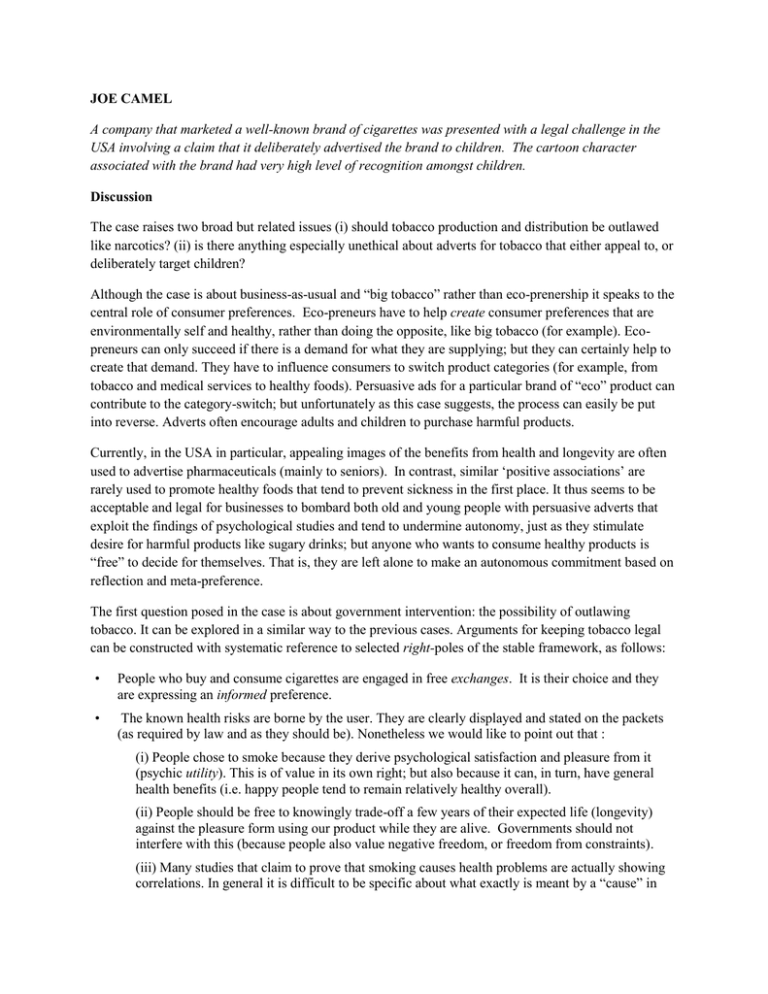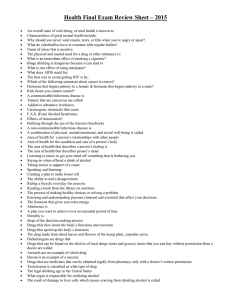MODEL ANSWER for JOE CAMEL
advertisement

JOE CAMEL A company that marketed a well-known brand of cigarettes was presented with a legal challenge in the USA involving a claim that it deliberately advertised the brand to children. The cartoon character associated with the brand had very high level of recognition amongst children. Discussion The case raises two broad but related issues (i) should tobacco production and distribution be outlawed like narcotics? (ii) is there anything especially unethical about adverts for tobacco that either appeal to, or deliberately target children? Although the case is about business-as-usual and “big tobacco” rather than eco-prenership it speaks to the central role of consumer preferences. Eco-preneurs have to help create consumer preferences that are environmentally self and healthy, rather than doing the opposite, like big tobacco (for example). Ecopreneurs can only succeed if there is a demand for what they are supplying; but they can certainly help to create that demand. They have to influence consumers to switch product categories (for example, from tobacco and medical services to healthy foods). Persuasive ads for a particular brand of “eco” product can contribute to the category-switch; but unfortunately as this case suggests, the process can easily be put into reverse. Adverts often encourage adults and children to purchase harmful products. Currently, in the USA in particular, appealing images of the benefits from health and longevity are often used to advertise pharmaceuticals (mainly to seniors). In contrast, similar ‘positive associations’ are rarely used to promote healthy foods that tend to prevent sickness in the first place. It thus seems to be acceptable and legal for businesses to bombard both old and young people with persuasive adverts that exploit the findings of psychological studies and tend to undermine autonomy, just as they stimulate desire for harmful products like sugary drinks; but anyone who wants to consume healthy products is “free” to decide for themselves. That is, they are left alone to make an autonomous commitment based on reflection and meta-preference. The first question posed in the case is about government intervention: the possibility of outlawing tobacco. It can be explored in a similar way to the previous cases. Arguments for keeping tobacco legal can be constructed with systematic reference to selected right-poles of the stable framework, as follows: • People who buy and consume cigarettes are engaged in free exchanges. It is their choice and they are expressing an informed preference. • The known health risks are borne by the user. They are clearly displayed and stated on the packets (as required by law and as they should be). Nonetheless we would like to point out that : (i) People chose to smoke because they derive psychological satisfaction and pleasure from it (psychic utility). This is of value in its own right; but also because it can, in turn, have general health benefits (i.e. happy people tend to remain relatively healthy overall). (ii) People should be free to knowingly trade-off a few years of their expected life (longevity) against the pleasure form using our product while they are alive. Governments should not interfere with this (because people also value negative freedom, or freedom from constraints). (iii) Many studies that claim to prove that smoking causes health problems are actually showing correlations. In general it is difficult to be specific about what exactly is meant by a “cause” in social and biological systems rather than a correlate or contributory factor. This continues to be an issue in the philosophy of science, even at the highest level. • There are many standard economic benefits to the tobacco industry as a whole. The industry employs many people, pays high taxes, funds philanthropic causes, contributes to financial-capital accumulation (shareholder value or wealth, with the possibility of ethics-later), as well as providing the consumer-surplus (psychic utility) mentioned above. In addition, as an Australian cost-benefit study once pointed out, there is an expected saving to governments on age-pensions (social security) due to the statistics that link earlier deaths to smoking. It may be impolitic for us to say this to say this, but it is nonetheless quite true. Overall, utilitarian moral reasoning (without a so-called justice constraint) in a form of a cost-benefit analysis shows that when all these benefits are set against the health care costs associated with the product, “we calculate that the net result is positive (i.e. there is an $ benefit to society as a whole). • Furthermore, the industry also has an important cultural role, often reflecting local history and maintaining traditions in many areas where it is farmed. This might be added to the “benefits” in any analysis. Arguments for outlawing tobacco (like narcotics) can then draw upon selected left poles of the stable framework, as follows: • The known health risks include harm to others from smoke in the air. The standard argument about free choice must always be set against any risks to others (an injustice), which is why some weapons and some behaviour-altering drugs are “outlawed”. • Tobacco products are addictive. The consumption of the product causes unintended and often undetected physiological changes which in turn create further psychological needs and desires for the product. This is actually a loss of autonomy or personal freedom (specifically, the positive freedom to develop). • It is beyond reasonable doubt that smoking increases the risk of many fatal diseases and statistically shortens life (a point already conceded by the “right”). Put simply smoking kills and there have been many victims. Anyone who doubts this should spend time in hospitals to see the damage for themselves. Any attempt to shed doubt on this fact amounts to the “corporate falsification of science” which has been described as “a crime against humanity” • There are many other safer products that can substitute for harmful tobacco and produce a comparable ‘psychic utility’ and sense of wellbeing. • Our cost-benefit-analysis actually shows a net loss (studies that show a gain are incomplete or biased in ways that inevitably reflect the interests of the industry). The total health care costs far exceed the benefits especially when the costs of medical treatment are relatively high, as in the USA. Furthermore, tobacco growing has often been subsidised, so removal of subsidy would be a social benefit. In any case, utilitarian arguments should incorporate a justice constraint which rule out tobacco marketing because of the extreme nature of the suffering involved in tobacco-related illnesses. • No culture is fixed and adjustments are often made to “traditional” practices. With regard to tradition generally, it is true that many people value being able to continue living in the way to which they have already become accustomed (Max Weber), but changes for producers like growing different crops, or modest adjustments to personal habits by consumers, are normally socially and politically acceptable. This is especially so if there are financial incentives to make the changes. Furthermore, the so-called “culture” of tobacco should not be all that highly valued because it has often involved poor working conditions and forms of slavery in many parts of the world. • The tobacco industry spends billions on advertising. These funds and the business skills of big tobacco should be applied instead to creating a market for genuinely healthy products. Business should help more people develop a desire for these by creating positive associations, then meeting the demand. Such as strategy would compensates for the most fundamental limitation of market based systems which is the distinction between revealed human preferences vs. actual human wellbeing. Advertising to children A second related aspect of this cigarette-advertising case raises the question of what is specifically unethical about adverts that happen to appeal to, or that deliberately ‘target’ children. Arguments from the economic-right , in defence of this practice include: • The use of cartoon characters is quite common for other branded products that “target” adults only. We are using a similar marketing strategy and we are not “deliberately targeting” children. • The alleged appeal of our cartoon image to children is based solely on their reported ability to recognize and identify the cartoon character. This does not imply that children are forming a disposition to purchase the advertised product, still less that they will try to obtain and use the product. • We have approved of laws preventing sales to children and we encourage parents to prevent children from smoking. We have even funded some anti-smoking campaigns that also use highly recognized images. Arguments from the left (and from some conservative religious sources) that oppose this practice include: • Children in general are more easily influenced by cartoons and by peer pressure. They are unlikely to have a proper understanding of the risks. They are unlikely to be reflective and they to be reckless and to trans-value; that is, bad behavior is often considered “cool” • Children should be protected by society, as discussed earlier in the glue-sniffing case. They are “the innocent ones”. They are not “fair game” for deceptive marketing tactics. Many have not yet learned to be skeptical or cynical about adverts. • More future years of a young person’s life are likely to be affected by the physiological changes caused by smoking. • Many children in America and around the World are hungry, do not eat healthy foods and are not having their basic needs reasonably met. It is thus obvious that the billions spent on advertising cigarettes (with or without cartoons) should be spent on providing healthy food and good medical care for children and adults (ethics now). Once again, safety and empowerment are the first priorities. As with other ethical and social issues, businesses should work with government and NGO’s to achieve these goals.




